Charles E W Bean, Diaries, AWM38 3DRL 606/244/1 - 1916 - 1933 - Part 15

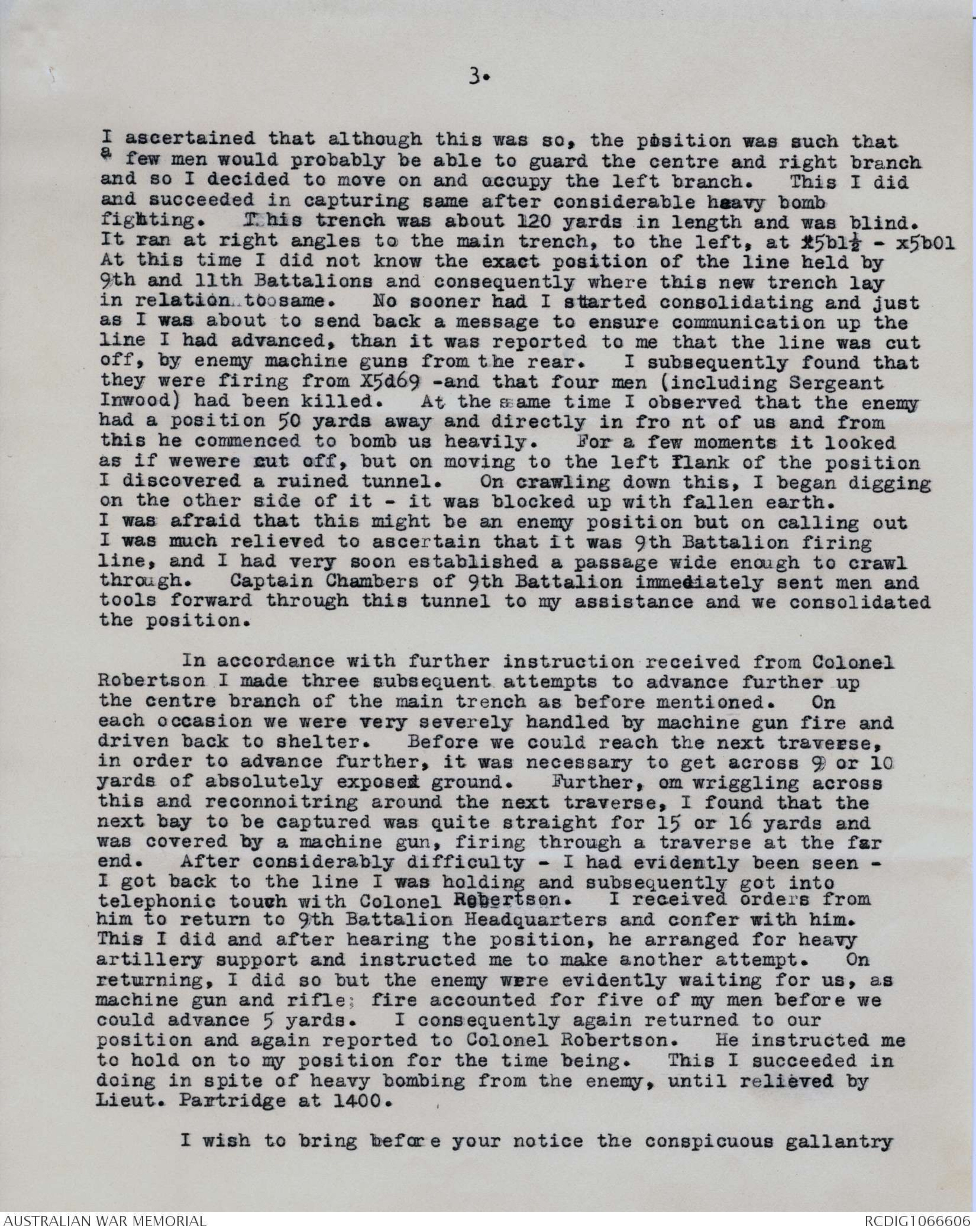
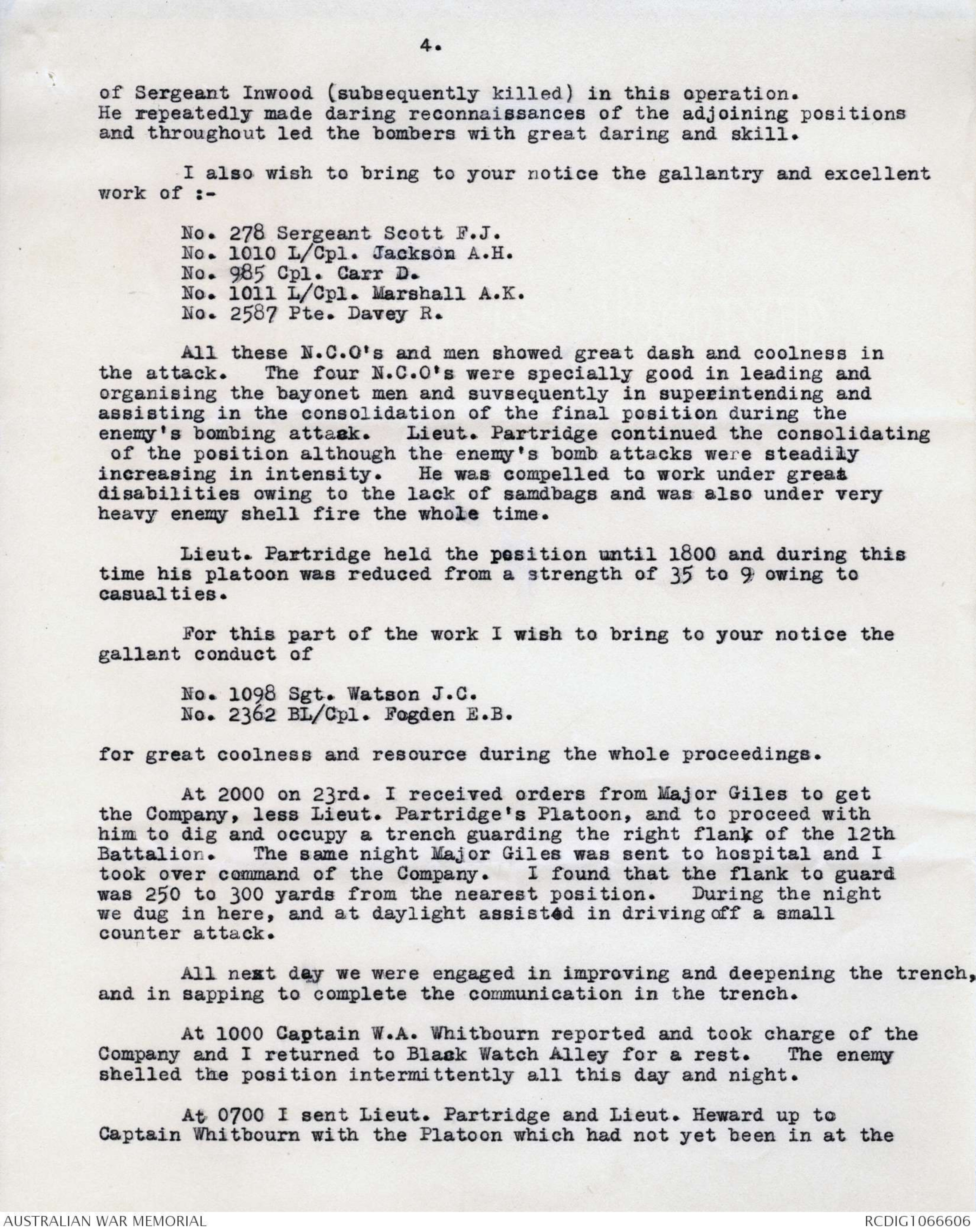
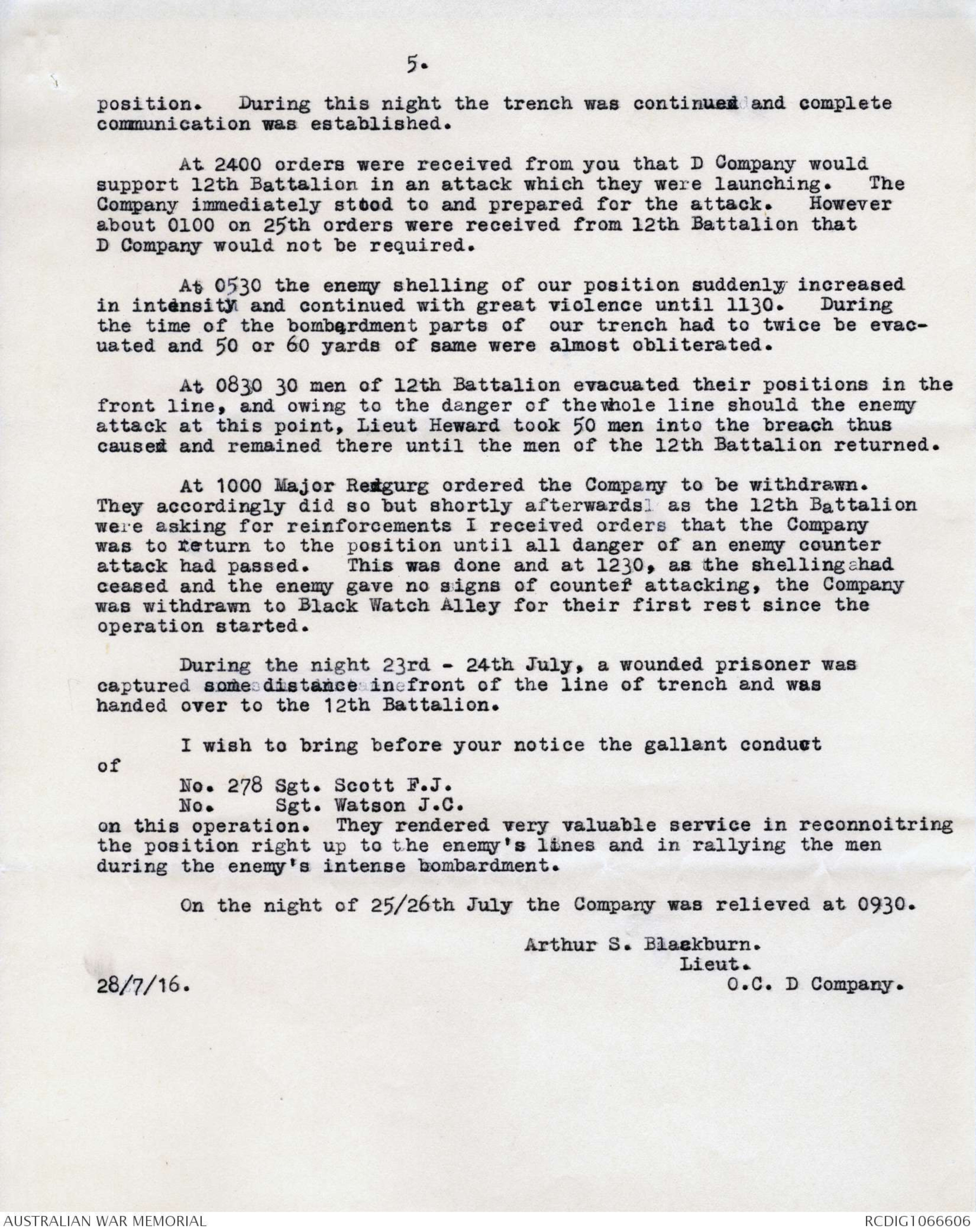
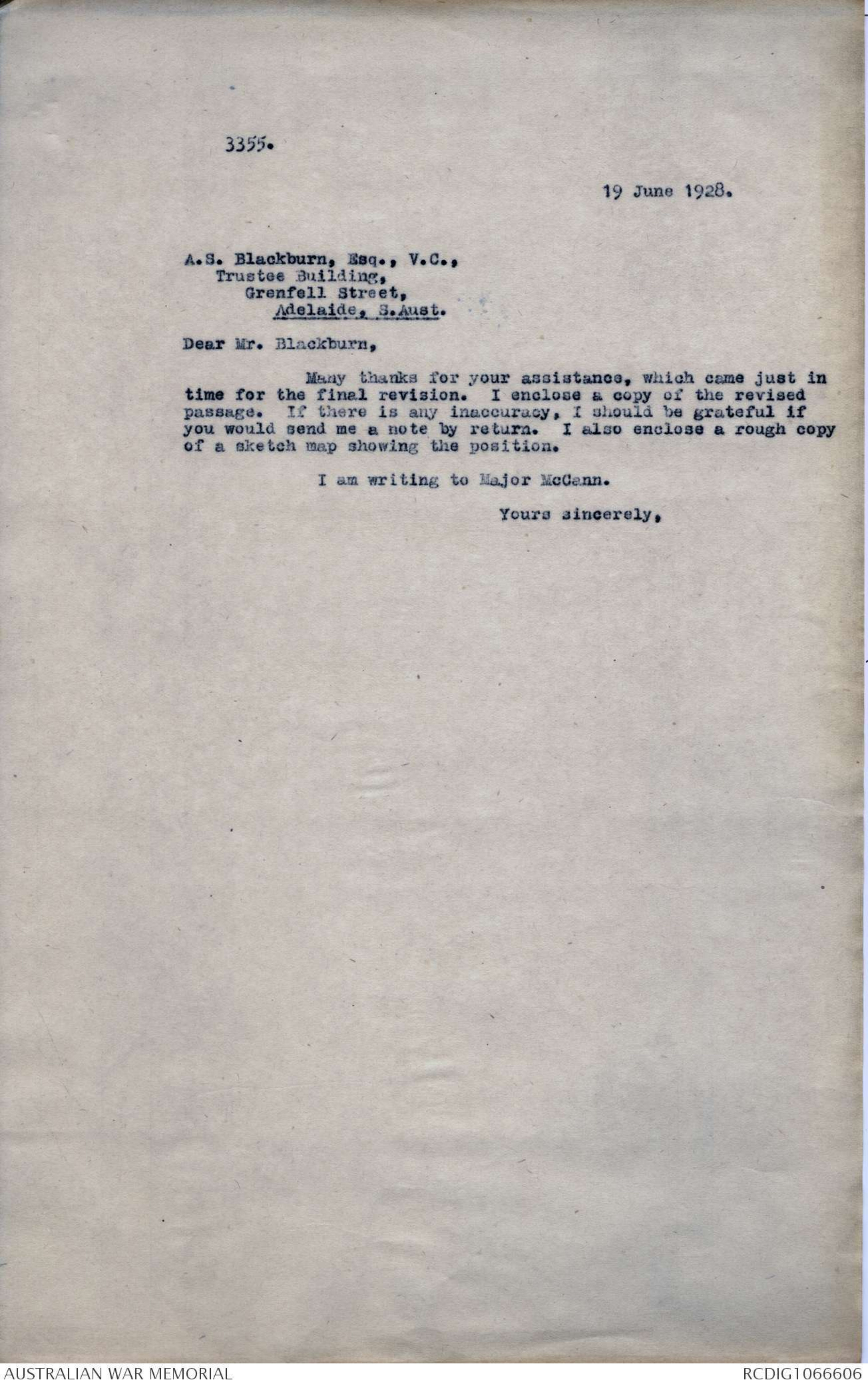
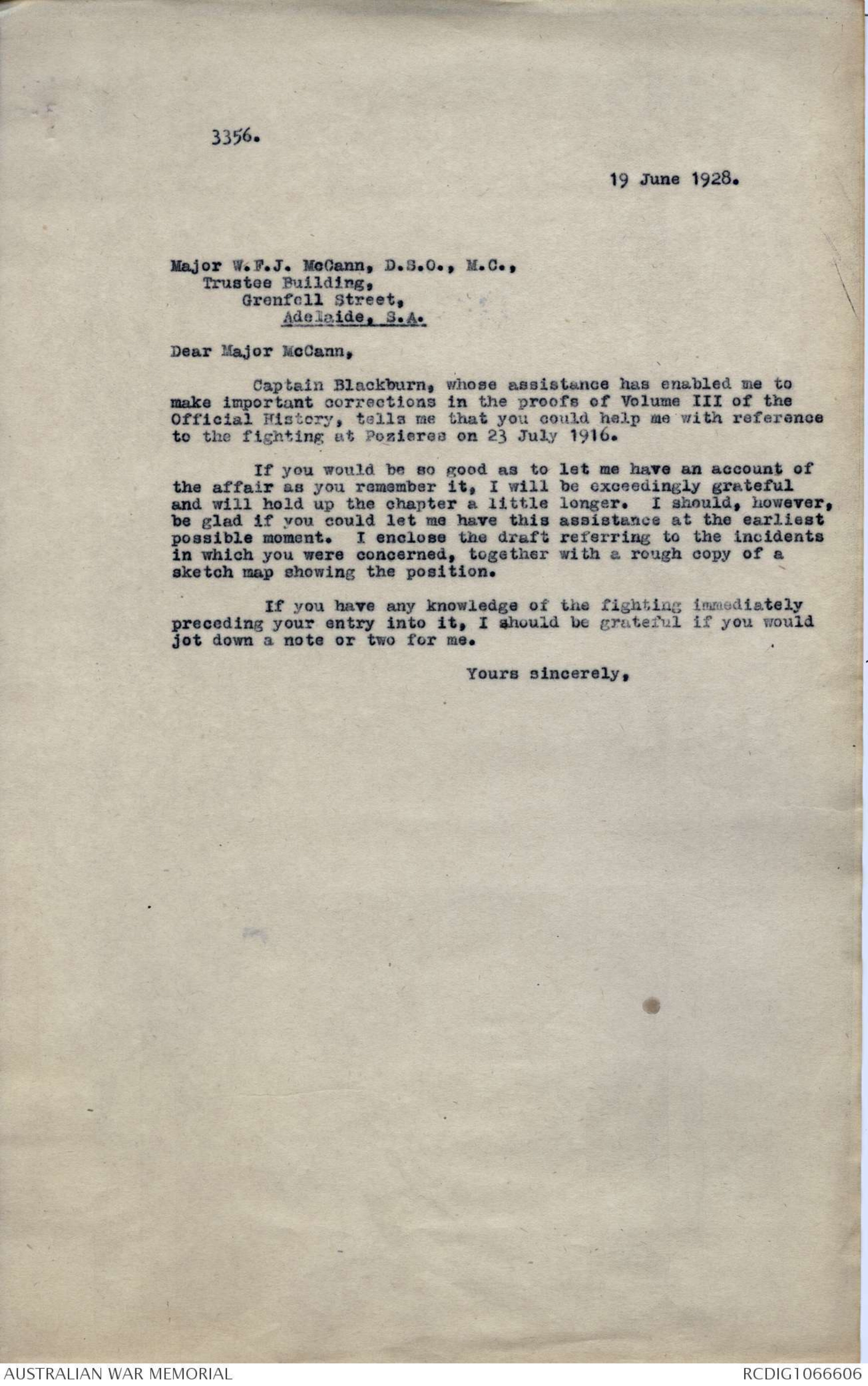
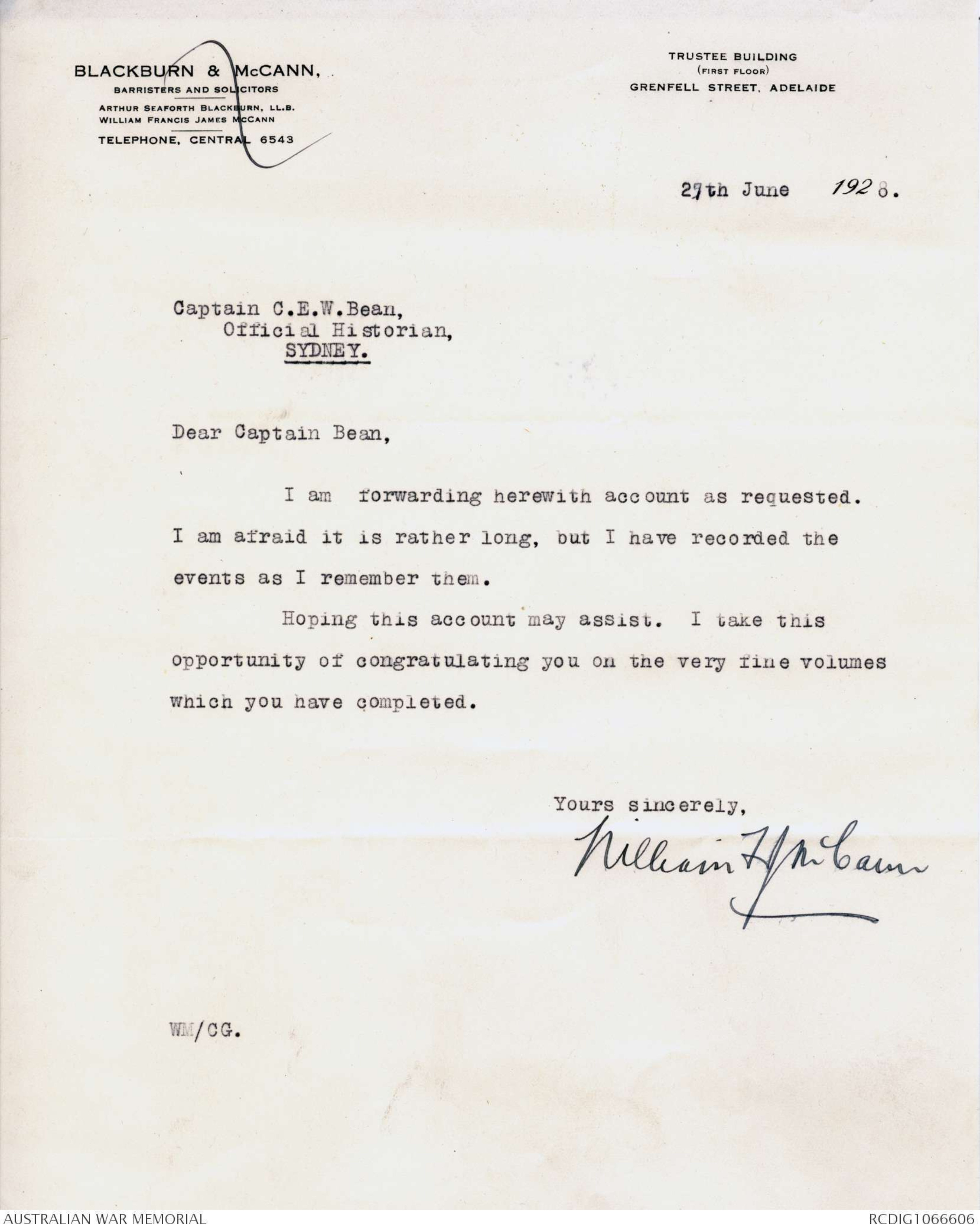
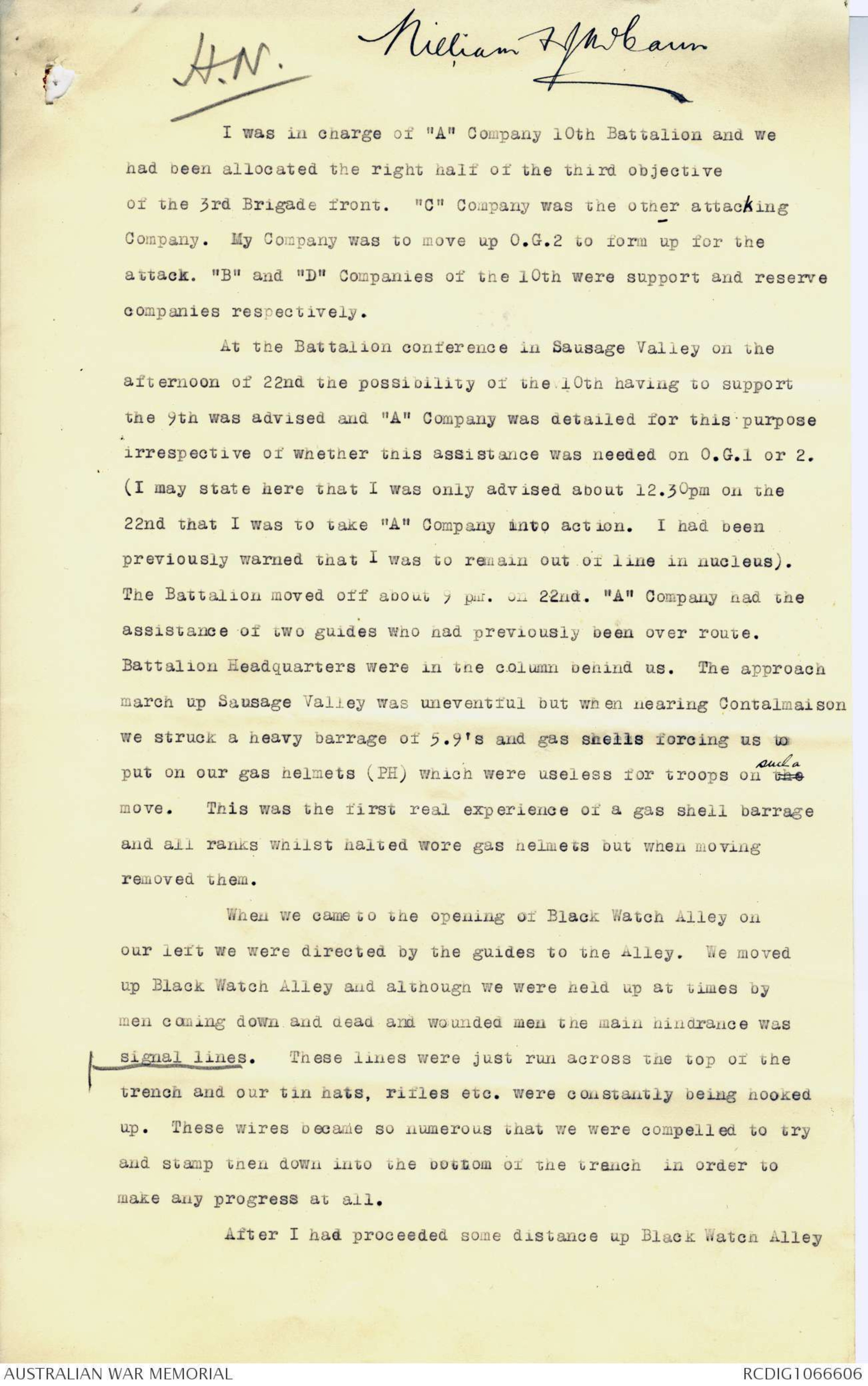
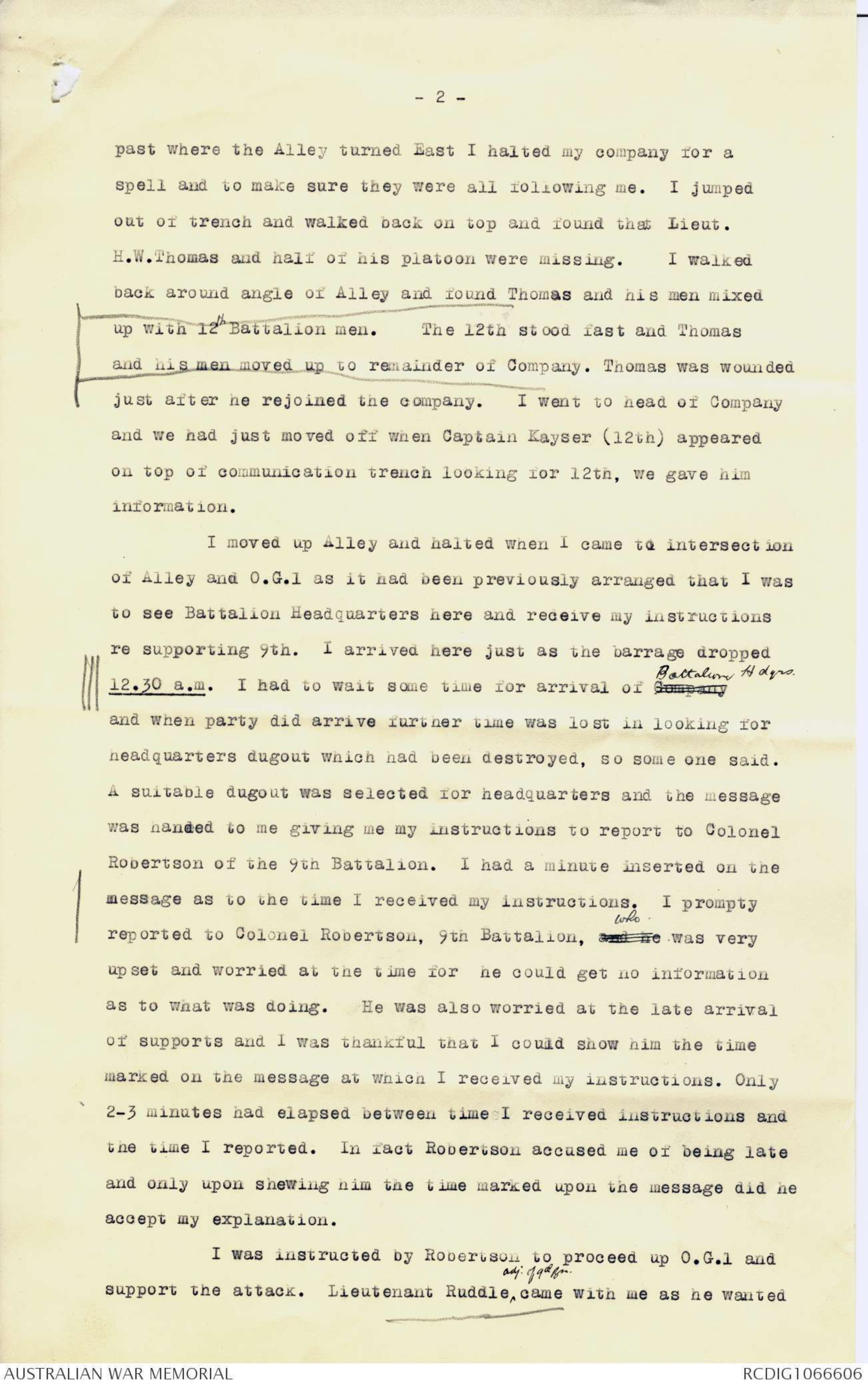
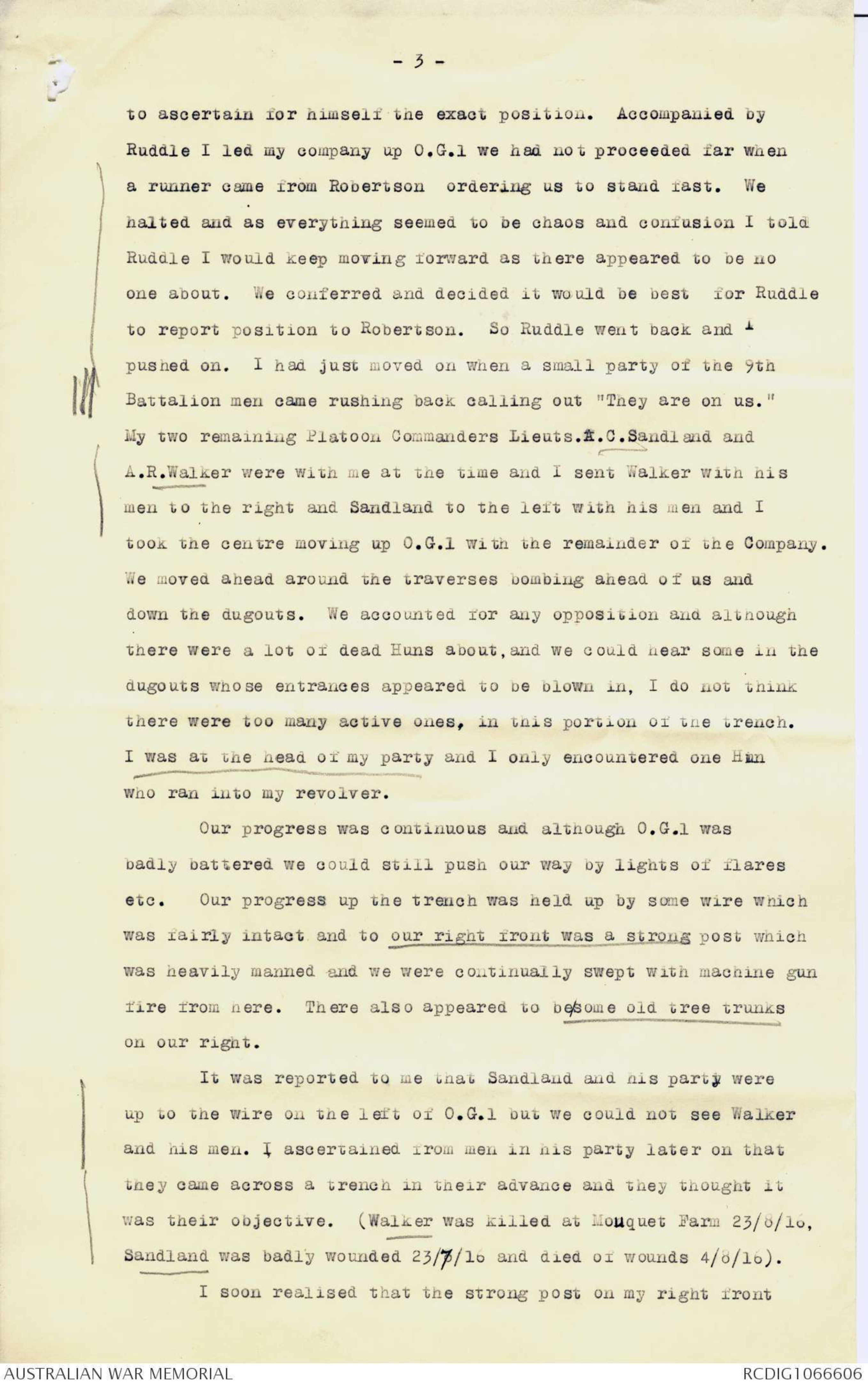
2.
approximately x5d 35½ onwards. On arrival at this point I found that
a barricade had been built across the trench and we were suffering
heavy casualties from snipers and machine guns at this point I also dis
discovered that the enemy had re-occupied portion of the trench on his
side of the barricade (from which he had previously been expelled for
a distance of 50 yards) and had commenced intermittent bombing.
My attacking party consisted of the 50 men above mentioned as bayonet men
men and reserve bombers, bomb carriers etc., and a team of bombers
from the Regimental Bombers. At a signal from me they rushed the
barricade breaking it down as much as possible in order to get past
it without undue exposure, get into position on the far side of it
and immediately in front of the first traverse. Owing to the limited
space between the barricade and the traverse, I found on looking around
that I had only six bombers and two bayonet men behind me. Consequently
I immediately bombed and then rushed the first bay and thus made
more room. Similarly as each bay was cleared room was made for more
men to follow on. At this stage snipers from an enemy trench
(approximately X5B4½- X5B?) and from directly ahead and machine guns
from the enemy trench on our right and parallel with the one I was
attacking gave much trouble (as they continued to do throughout this
operation). By means of heavy bomb fighting the attack was gradually
pushed on until we had driven the enemy out of approximately 150 yards
of trench. At this stage, at X5d 29½, I was brought to a halt, partly
to give the men a short "breather" and partly because of the nature
of the ground ahead of us. Our artillery bombardment had almost
obliterated the trench and reduced it to a series of shell craters.
To get from one to another of these it was necessary to fully expose
oneself to a very heavy machine gum fire. In addition the enemy
were manning a shell crater about 30 hards away and were bombing us
from there. We were considerably hampered by the fact that we were
compelled owing to lack of shelter to lie out flat and consequently
could not use bombs effectively. I crawled forward with four men
in order to ascertain exactly where the machine gun fire was coming
from and found that the enemy had a strong redoubt at X5b2½.
Unfortunately in order to see this we were compelled to expose
ourselves and the four men were all killed. I reported the position
to Col. Robertson 9th Battalion (under whose orders I was working)
and he immediately arranged for Trench Mortars to bombard the enemy
positions at X5b2½ and elsewhere. Under cover of this bombardment
I again endeavoured to push on but found that the machine gun fire
was undiminished and as I had lost four more men killed or wounded
by the time I had gone five yards I again desisted from the attempt
to push forward. I reported to Col. Robertson again and he arranged
for artillery to support the bombardment. Under cover of this I
succeeded in pushing on for another 30 yards, with the loss of only
two more men. Immediately prior to this a second team of bombers
had arrived to help me with the attack. I was now hung up by severe
bombing. My bombers engaged the enemy and under cover of this, Sgt.
Inwood and myself crawled forward to reconnoitre the position as it
appeared to me that an enemy trench cut the trench I was attacking at
right angles, thus making a junction with three branches to attack.
3-
I ascertained that although this was so, the position was such that
a few men would probably be able to guard the centre and right branch
and so I decided to move on and occupy the left branch. This I did
and succeeded in capturing same after considerable heavy bomb
fighting. This trench was about 120 yards in length and was blind.
It ran at right angles to the main trench, to the left, at x5b1½- x5b01
At this time I did not know the exact position of the line held by
9th and 11th Battalions and consequently where this new trench lay
in relation to same. No sooner had I started consolidating and just
as I was about to send back a message to ensure communication up the
line I had advanced, than it was reported to me that the line was cut
off, by enemy machine guns from the rear. I subsequently found that
they were firing from X5d69 -and that four men (including Sergeant
Inwood) had been killed. At the same time I observed that the enemy
had a position 50 yards away and directly in fro nt of us and from
this he commenced to bomb us heavily. For a few moments it looked
as if wewere cut off, but on moving to the left flank of the position
I discovered a ruined tunnel. On crawling down this, I began digging
on the other side of it - it was blocked up with fallen earth.
I was afraid that this might be an enemy position but on calling out
I was much relieved to ascertain that it was 9th Battalion firing
line, and I had very soon established a passage wide enough to crawl
through. Captain Chambers of 9th Battalion immediately sent men and
tools forward through this tunnel to my assistance and we consolidated
the position.
In accordance with further instruction received from Colonel
Robertson I made three subsequent attempts to advance further up
the centre branch of the main trench as before mentioned. On
each occasion we were very severely handled by machine gun fire and
driven back to shelter. Before we could reach the next traverse,
in order to advance further, it was necessary to get across 9 or 10
yards of absolutely exposes ground. Further, om wriggling across
this and reconnoitring around the next traverse, I found that the
next bay to be captured was quite straight for 15 or 16 yards and
was covered by a machine gun, firing through a traverse at the far
end. After considerably difficulty - I had evidently been seen -
I got back to the line I was holding and subsequently got into
telephonic touch with Colonel Robertson. I received orders from
him to return to 9th Battalion Headquarters and confer with him.
This I did and after hearing the position, he arranged for heavy
artillery support and instructed me to make another attempt. On
returning, I did so but the enemy were evidently waiting for us, as
machine gun and rifle; fire accounted for five of my men before we
could advance 5 yards. I consequently again returned to our
position and again reported to Colonel Robertson. He instructed me
to hold on to my position for the time being. This I succeeded in
doing in spite of heavy bombing from the enemy, until relieved by
Lieut. Partridge at 1400.
I wish to bring before your notice the conspicuous gallantry
4.
of Sergeant Inwood (subsequently killed) in this operation.
He repeatedly made daring reconnaissances of the adjoining positions
and throughout led the bombers with great daring and skill.
I also wish to bring to your notice the gallantry and excellent
work of :-
No. 278 Sergeant Scott F.J.
No. 1010 L/Cpl. Jackson A.H.
No. 985 Cpl. Carr D.
No. 1011 L/Cpl. Marshall A.K.
No. 2587 Pte. Davey R.
All these N.C.O's and men showed great dash and coolness in
the attack. The four N.C.O's were specially good in leading and
organising the bayonet men and subsequently in superintending and
assisting in the consolidation of the final position during the
enemy's bombing attack. Lieut. Partridge continued the consolidating
of the position although the enemy's bomb attacks were steadily
increasing in intensity. He was compelled to work under great
disabilities owing to the lack of samdbags and was also under very
heavy enemy shell fire the whole time.
Lieut. Partridge held the position until 1800 and during this
time his platoon was reduced from a strength of 35 to 9 owing to
casualties.
For this part of the work I wish to bring to your notice the
gallant conduct of
No. 1098 Sgt. Watson J.C.
No. 2362 BL/Cpl. Fogden E.B.
for great coolness and resource during the whole proceedings.
At 2000 on 23rd. I received orders from Major Giles to get
the Company, less Lieut. Partridge's Platoon, and to proceed with
him to dig and occupy a trench guarding the right flank of the 12th
Battalion. The same night Major Giles was sent to hospital and I
took over command of the Company. I found that the flank to guard
was 250 to 300 yards from the nearest position. During the night
we dug in here, and at daylight assisted in driving off a small
counter attack.
All next day we were engaged in improving and deepening the trench
and in sapping to complete the communication in the trench.
At 1000 Captain W.A. Whitbourn reported and took charge of the
Company and I returned to Black Watch Alley for a rest. The enemy
shelled the position intermittently all this day and night.
At 0700 I sent Lieut. Partridge and Lieut. Heward up to
Captain Whitbourn with the Platoon which had not yet been in at the
5.
position. During this night the trench was continued and complete
communication was established.
At 2400 orders were received from you that D Company would
support 12th Battalion in an attack which they were launching. The
Company immediately stood to and prepared for the attack. However
about 0100 on 25th orders were received from 12th Battalion that
D Company would not be required.
At 0530 the enemy shelling of our position suddenly increased
in intensity and continued with great violence until 1130. During
the time of the bombardment parts of our trench had to twice be evacuated
and 50 or 60 yards of same were almost obliterated.
At 0830 30 men of 12th Battalion evacuated their positions in the
front line, and owing to the danger of the whole line should the enemy
attack at this point, Lieut Heward took 50 men into the breach thus
caused and remained there until the men of the 12th Battalion returned.
At 1000 Major Rexgurg ordered the Company to be withdrawn.
They accordingly did so but shortly afterwards as the 12th Battalion
were asking for reinforcements I received orders that the Company
was to return to the position until all danger of an enemy counter
attack had passed. This was done and at 1230, as the shelling had
ceased and the enemy gave no signs of counter attacking, the Company
was withdrawn to Black Watch Alley for their first rest since the
operation started.
During the night 23rd - 24th July, a wounded prisoner was
captured some distance in front of the line of trench and was
handed over to the 12th Battalion.
I wish to bring before your notice the gallant conduct
of
No. 278 Sgt. Scott F.J.
No. Sgt. Watson J.C.
on this operation. They rendered very valuable service in reconnoitring
the position right up to the enemy's lines and in rallying the men
during the enemy's intense bombardment.
On the night of 25/26th July the Company was relieved at 0930.
Arthur S. Blackburn.
Lieut.
O.C. D Company.
28/7/16.
3355.
19 June 1928.
A.S. Blackburn, Esq.. V.C..
Trustee Building,
Grenfell Street
Adelaide, S.Aust.
Dear Mr. Blackburn,
Many thanks for your assistance, which came just in
time for the final revision. I enclose a copy of the revised
passage. If there is any inaccuracy, I should be grateful if
you would send me a note by return. I also enclose a rough copy
of a sketch map showing the position.
I am writing to Major McCann.
Yours sincerely.
3356.
19 June 1928.
Major W.F.J. McCann, D.S.O., M.C.,
Trustee Building,
Grenfell Street
Adelaide, S.A.
Dear Major McCann,
Captain Blackburn, whose assistance has enabled me to
make important corrections in the proofs of Volume III of the
Official History, tells me that you could help me with reference
to the fighting at Pozieres on 23 July 1916.
If you would be so good as to let me have an account of
the affair as you remember it, I will be exceedingly grateful
and will hold up the chapter a little longer. I should, however,
be glad if you could let me have this assistance at the earliest
possible moment. I enclose the draft referring to the incidents
in which you were concerned, together with a rough copy of a
sketch map showing the position.
If you have any knowledge of the fighting immediately
preceding your entry into it, I should be grateful if you would
jot down a note or two for me.
Yours sincerely,
TRUSTEE BUILDING
(FIRST FLOOR)
GRENFELL STREET, ADELAIDE
BLACKSBURN & McCANN
BARRISTERS AND SOLICITORS
ARTHUR SEAFORTH BLACKRURN, LL.B.
WILLIAM FRANCIS JAMES MCCANN
TELEPHONE, CENTRAL 6543
27th June 1928.
Captain C.E.W.Bean
Official Historian,
SYDNEY.
Dear Captain Bean,
I am forwarding herewith account as requested.
I am afraid it is rather long, but I have recorded the
events as I remember them.
Hoping this account may assist. I take this
opportunity of congratulating you on the very fine volumes
which you have completed.
Yours sincerely,
William FJ McCann
WM/CG.
H.N.
William H. J. McCann
I was in charge of "A" Company 10th Battalion and we
had been allocated the right half of the third objective
of the 3rd Brigade front. "C" Company was the other attacking
Company. My Company was to move up O.G.2 to form up for the
attack. "B" and "D" Companies of the 10th were support and reserve
companies respectively.
At the Battalion conference in Sausage Valley on the
afternoon of 22nd the possibility of the. 10th having to support
the 9th was advised and "A" Company was detailed for this purpose
irrespective of whether this assistance was needed on O.G.1 or 2.
(I may state here that I was only advised about 12.30pm on the
22nd that I was to take "A" Company into action. I had been
previously warned that I was to remain out of line in nucleus).
The Battalion moved off about 9 pm. On 22nd. "A" Company had the
assistance of two guides who had previously been over route.
Battalion Headquarters were in the column behind us. The approach
march up Sausage Valley was uneventful but when nearing Contalmaison
we struck a heavy barrage of 5.9's and gas shells forcing us to
put on our gas helmets (PH) which were useless for troops on such a the
move. This was the first real experience of a gas shell barrage
and all ranks whilst halted wore gas helmets but when moving
removed them.
When we came to the opening of Black Watch Alley on
our left we were directed by the guides to the Alley. We moved
up Black Watch Alley and although we were held up at times by
men coming down and dead and wounded men the main hindrance was
signal lines. These lines were just run across the top of the
trench and our tin hats, rifles etc. were constantly being hooked
up. These wires became so numerous that we were compelled to try
and stamp then down into the bottom of the trench in order to
make any progress at all.
After I had proceeded some distance up Black Watch Alley
-2 -
past where the Alley turned East I halted my company for a
spell and to make sure they were all following me. I jumped
out of trench and walked back on top and found that Lieut.
H.W.Thomas and half of his platoon were missing. I walked
back around angle of Alley and found Thomas and his men mixed
up with 12th Battalion men. The 12th stood fast and Thomas
and his men moved up to remainder of Company. Thomas was wounded
just after he rejoined the company. I went to head of Company
and we had just moved off when Captain Kayser (12th) appeared
on top of communication trench looking for 12th, we gave him
information.
I moved up Alley and halted when I came to intersection
of Alley and O.G.1 as it had been previously arranged that I was
to see Battalion Headquarters here and receive my instructions
re supporting 9th. I arrived here just as the barrage dropped
12.30 a.m. I had to wait some time for arrival of Company Battalion Hdqrs
and when party did arrive further time was lost in looking for
headquarters dugout which had been destroyed, so some one said.
A suitable dugout was selected for headquarters and the message
was handed to me giving me my instructions to report to Colonel
Robertson of the 9th Battalion. I had a minute inserted on the
message as to the time I received my instructions. I prompty
reported to Colonel Robertson, 9th Battalion, and he who was very
upset and worried at the time for, he could get no information
as to what was doing. He was also worried at the late arrival
of supports and I was thankful that I could show him the time
marked on the message at which I received my instructions. Only
2-3 minutes had elapsed between time I received instructions and
the time I reported. In fact Robertson accused me of being late
and only upon shewing him the time marked upon the message did he
accept my explanation.
I was instructed by Robertson to proceed up O.G.1 and
support the attack. Lieutenant Ruddle, ^adj of 8th Bn. came with me as he wanted
-3 -
to ascertain for himself the exact position. Accompanied by
Ruddle I led my company up O.G.1 we had not proceeded far when
a runner came from Robertson ordering us to stand fast. We
halted and as everything seemed to be chaos and confusion I told
Ruddle I would keep moving forward as there appeared to be no
one about. We conferred and decided it would be best, for Ruddle
to report position to Robertson. So Ruddle went back and
pushed on. I had just moved on when a small party of the 9th
Battalion men came rushing back calling out "They are on us."
My two remaining Platoon Commanders Lieuts. A.C.Sandland and
A.R.Walker were with me at the time and I sent Walker with his
men to the right and Sandland to the left with his men and I
took the centre moving up O.G.1 with the remainder of the Company.
We moved ahead around the traverses bombing ahead of us and
down the dugouts. We accounted for any opposition and although
there were a lot of dead Huns about, and we could hear some in the
dugouts whose entrances appeared to be blown in, I do not think
there were too many active ones, in this portion of the trench.
I was at the head of my party and I only encountered one Hun
who ran into my revolver.
Our progress was continuous and although O.G.1 was
badly battered we could still push our way by lights of flares
etc. Our progress up the trench was held up by some wire which
was fairly intact and to our right front was a strong post which
was heavily manned and we were continually swept with machine gun
fire from here. There also appeared to be some old tree trunks
on our right.
It was reported to me that Sandland and nis party were
up to the wire on the left of O.G.1 but we could not see Walker
and his men. I ascertained from men in his party later on that
they came across a trench in their advance and they thought it
was their objective. (Walker was killed at Mouquet Farm 23/8/16,
Sandland was badly wounded 23/7/16 and died of wounds 4/8/16).
I soon realised that the strong post on my right front
 Sam scott
Sam scottThis transcription item is now locked to you for editing. To release the lock either Save your changes or Cancel.
This lock will be automatically released after 60 minutes of inactivity.